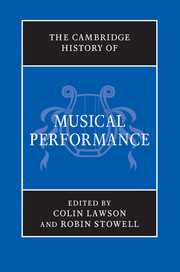Book contents
- Frontmatter
- PART I PERFORMANCE THROUGH HISTORY
- PART II PRE-RENAISSANCE PERFORMANCE
- 7 The Ancient World
- 8 Performance before c. 1430: an overview
- 9 Vocal performance before c. 1430
- 10 Instrumental performance before c. 1430
- 11 Case study: Guillaume de Machaut, ballade 34, ‘Quant Theseus / Ne quier veoir’
- PART III PERFORMANCE IN THE RENAISSANCE (C. 1430–1600)
- PART IV PERFORMANCE IN THE SEVENTEENTH CENTURY
- PART V PERFORMANCE IN THE ‘LONG EIGHTEENTH CENTURY’
- PART VI PERFORMANCE IN THE NINETEENTH CENTURY
- PART VII THE TWENTIETH CENTURY AND BEYOND
- PART VIII
- Index
11 - Case study: Guillaume de Machaut, ballade 34, ‘Quant Theseus / Ne quier veoir’
from PART II - PRE-RENAISSANCE PERFORMANCE
Published online by Cambridge University Press: 28 March 2012
- Frontmatter
- PART I PERFORMANCE THROUGH HISTORY
- PART II PRE-RENAISSANCE PERFORMANCE
- 7 The Ancient World
- 8 Performance before c. 1430: an overview
- 9 Vocal performance before c. 1430
- 10 Instrumental performance before c. 1430
- 11 Case study: Guillaume de Machaut, ballade 34, ‘Quant Theseus / Ne quier veoir’
- PART III PERFORMANCE IN THE RENAISSANCE (C. 1430–1600)
- PART IV PERFORMANCE IN THE SEVENTEENTH CENTURY
- PART V PERFORMANCE IN THE ‘LONG EIGHTEENTH CENTURY’
- PART VI PERFORMANCE IN THE NINETEENTH CENTURY
- PART VII THE TWENTIETH CENTURY AND BEYOND
- PART VIII
- Index
Summary
This chapter explores the issues laid out in Chapter 8 by inspecting a well-studied piece, Guillaume de Machaut's ballade 34, ‘Quant Theseus / Ne quier veoir’. The circumstances surrounding the creation of this ballade illustrate its remoteness from the bulk of music-making of the mid-fourteenth century. Still, something can and will be said about the performance of Machaut's ballade, inasmuch as it contrasts with the majority of music performed in the Middle Ages. It seems apposite to start outside ballade 34 by looking at the countless pieces of menial music performed around the time and near the place Machaut put together his learned musical composition. As outlined in Chapter 8, we begin with music made at work, from humble work songs to official ceremonial pieces, and then move to music whose primary purpose is to edify, from liturgical chants to songs performed at banquets. The point of my selecting this well-known ballade is to show how a piece such as this misrepresents the average medieval music performance. By holding Machaut's famous ballade under the light of the revised view of music history proposed in Chapter 8, we begin to see it as a paradox, an extraordinary written work far removed from the mainstream performance world of the mid-fourteenth century.
- Type
- Chapter
- Information
- The Cambridge History of Musical Performance , pp. 279 - 294Publisher: Cambridge University PressPrint publication year: 2012

